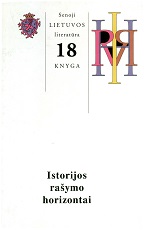M.K. Sarbievijaus odės Švč. Mergelei Marijai: krikščioniškosios poezijos raidos atspindžiai
ODES TO THE BLESSED VIRGIN MARY BY M.K. SARBIEVIJUS: REFLECTIONS OF THE DEVELOPMENT OF CHRISTIAN POETRY (STELLA MARIS)
Author(s): Ona DaukšienėSubject(s): Literary Texts
Published by: Lietuvių literatūros ir tautosakos institutas
Keywords: Poetical compositions of religious character of the poetical heritage by Motiejus Kazimieras Sarbievijus;
Summary/Abstract: Poetical compositions of religious character constitute probably the most interesting and complicated, although not the largest, part of the poetical heritage by Motiejus Kazimieras Sarbievijus. His odes and epodes dedicated to the Holy Virgin should be segregated into a separate thematical and semantical group. Four odes from the second book of Lyricorum libri IV (Antverpiae, 1634) have been directly dedicated to the Holy Virgin Mary (Ad D. Virginem Matrem), i.e. Nos. 11, 14, 18, 62; she is also an addressee of the ode II, 13 – Ad Julium Rosam. Besides, six odes from the fourth book (Nos. 18, 20, 22, 24, 25, 33) have also been dedicated to the Holy Virgin, while motives related to her could as well be discerned in the 21st one, inspired by the Song of Songs: here, just like in one ode of the six mentioned above (No. 25), the author uses symbols from the Song of Songs, traditionally related to the Blessed Virgin. And finally, Mary is an addressee of the cycle of four epodes, Quattuor leucae Virginis Matris, inspired by the personal experiences of the author while participating in one of the rhapsodic processions from Vilnius to the Church of the Blessed Virgin in Trakai, arranged by Jesuits.The religious poetry by Sarbievijus is characterized by a special quality: even his singlesided, “shallow” texts, at first sight presenting nothing else than close imitations of certain Horatian hymns, upon closer scrutiny reveal numerous hidden semantical, verbal and visual layers. Thus, in his rather early ode (II, 11), besides clear imitations of Horatian texts (Carm. I, 35 and III, 4), one can discern the glorious image of the Virgin Mary being depicted; while in ode II, 13, which also imitates Horace (Carm. III, 28) rather closely, the biblical images and iconographic patterns can be revealed under the multileveled poetical words: Mary is depicted here as standing on the moon and shrouded in the sun like a wrap (cf. Apr 12, 1 and toga in the Sarbievian text). These poems by Sarbievijus are very expressive, both visually and verbally, thus demonstrating the baroque synthesis of image and word. In ode 14 from the second book, written upon the occasion of Andriejus Rudamina leaving for the Eastern missions, wherein Mary is asked to guard his ship and protect it from storms, the favourite Italian humanist motive of Mary as the sea star, stella maris, the guardian of seafarers, is elaborated upon, covered in Horatian lexical expressions (esp. Carm. III, 22, IV). Thus we come upon the main image of the liturgical hymn Ave maris stella here. This popular medieval hymn has already absorbed the earlier invocations addressed to Mary and probably the previously devised Christian textual images; variations of separate strophes from this hymn can be found in earlier hymns to Mary, created by Venancijus Fortunatus in the 6th century A.D., by Paul Deacon in 799 and by some others...
Journal: Senoji Lietuvos literatūra
- Issue Year: 2004
- Issue No: XVIII
- Page Range: 169-187
- Page Count: 19
- Language: Lithuanian

